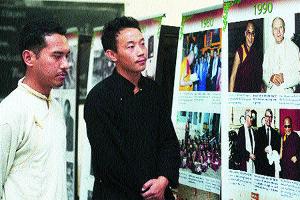Smiling through their losses
Tibetan expats have put up a two-day photo exhibition to create awareness about their homeland among youngsters in Kerala
For Tibetan expats, Kerala is a home away from home. As Namgil Psundu, a Tibetan expat settled in Kerala for the last 25 years, puts it, “We feel safe here and have everything we need to sustain our tradition. We do not want to go to our homeland to be tortured.”
However, none of them have forgotten the hardships that they have had to suffer back home following the Chinese occupancy and rule in Tibet since 1956. And they want people in Kerala to know what they have gone through in the past. A two-day photo exhibition put up by the Tibetan expats in Kochi is an attempt towards the same. As many as 60 photographs are on display at the ongoing exhibition organised by the Tibet Museum of the Department of Information and International Relations, Central Tibetan Administration in Dharmsala, Himachal Pradesh, and Friends of Tibet (Kerala Chapter).
Contributed by a few international photographers and tourists, each picture throws light on the life of Tibetans and Tibetan expats. The photographs have been divided into two segments — The Burning Question: Why are Tibetans turning to self-immolations, and Tibet journey into exile. While the former offers a glimpse into the struggles of Tibetans for freedom, the latter is a token of gratitude to the Indian government and its people for extending their undying support to the Tibetan expats.
Tashi Phuntsok, director of the Tibet Museum, says the the exhibition is organised to create awareness among youngsters in Kerala about their homeland. “We want to create awareness about the Tibetan life among non-Tibetans. We want them to know what is happening inside Tibet, how our people are oppressed and forbidden to practise our religious belief. As a mass protest, some have even taken the drastic step of self-immolation for the same. We want to educate the younger generation about the culture and heritage of Tibet and conserve it for posterity,” says Tashi.
Incidentally, as about 2000 Tibetans come to India in exile every year, and they engage in several professions for a livelihood. There are labourers, farmers, singers and businessmen among them. “There are about 53 Tibetan settlements in India, especially in Karnataka. Among them, 20 to 40 families are settled in Kerala, scattered across Kochi, Trivandrum and Varkala,” explains Namgil and adds, “There is a sense of brotherhood here. We carry out our work like everybody else. Keralities have been cooperative in helping us sustain ourselves, revive and pass on our culture, language and religion to our children,” says Namgil.
Samtan, a Tibetan expat, who has been doing business in Kochi for the last 20 years says, “Locals are eager to know about the Tibetan culture and even learn the language. Keralites love our food too, especially momos and chowmein.”
But do they miss their homeland? “The only aspect we miss in Kerala is Buddhist shrines. But otherwise we are like any other Malayali today,” Samtan says.

